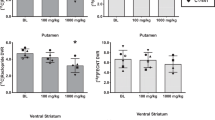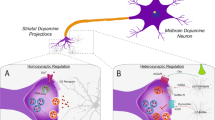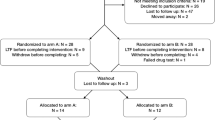Abstract
Research using rodent models has established a relationship between the steroid hormone estrogen and dopamine function, by revealing changes throughout the estrous cycle and by directly manipulating neuroendocrine signaling through ovariectomy and administration of estrogen. However, a direct link between estrogen levels and dopamine signaling had not been established in humans. The goal of this study, therefore, was to assess the relationship between circulating 17β-estradiol and dopamine signaling in the human brain by testing for a relationship between two proxies for these variables: peripheral 17β-estradiol and striatal dopamine D2-type receptor availability, measured with [18F]fallypride and positron emission tomography (PET). Sixteen (23–45 years of age) women were tested on 2 days of the menstrual cycle estimated prospectively to occur during (a) the early follicular phase, when estrogen levels are near their nadir, and (b) the periovulatory phase, when estrogen levels peak. PET scans with [18F]fallypride were performed on these 2 days, and serum 17β-estradiol was measured using radioimmunoassay. Dopamine D2-type receptor availability did not differ significantly in the whole striatum or the caudate, putamen, or accumbens subregions during the high-estrogen vs. the low-estrogen phases of the menstrual cycle. We conclude that circulating estrogen levels do not affect dopamine D2-type receptor availability in the human striatum although other indices of dopaminergic function may be affected.
This is a preview of subscription content, access via your institution
Access options
Subscribe to this journal
Receive 12 print issues and online access
$259.00 per year
only $21.58 per issue
Buy this article
- Purchase on Springer Link
- Instant access to full article PDF
Prices may be subject to local taxes which are calculated during checkout



Similar content being viewed by others
References
Gillies GE, Pienaar IS, Vohra S, Qamhawi Z. Sex differences in Parkinson’s disease. Front Neuroendocrinol. 2014;35:370–84.
Shulman LM, Bhat V. Gender disparities in Parkinson’s disease. Expert Rev Neurother. 2006;6:407–16.
Smith KM, Dahodwala N. Sex differences in Parkinson’s disease and other movement disorders. Exp Neurol. 2014;259:44–56.
SAMHSA. Key substance use and mental health indicators in the United States: results from the 2018 National Survey on Drug Use and Health. 2019;1–39.
Smith PH, Bessette AJ, Weinberger AH, Sheffer CE, McKee SA. Sex/gender differences in smoking cessation: a review. Preventive Med. 2016;92:135–40.
Foster KT, Hicks BM, Iacono WG, McGue M. Gender differences in the structure of risk for alcohol use disorder in adolescence and young adulthood. Psychol Med. 2015;45:3047–58.
Griffin ML, Bennett HE, Fitzmaurice GM, Hill KP, Provost SE, Weiss RD. Health-related quality of life among prescription opioid-dependent patients: results from a multi-site study. Am J Addict. 2015;24:308–14.
Becker JB, Perry AN, Westenbroek C. Sex differences in the neural mechanisms mediating addiction: a new synthesis and hypothesis. Biol Sex Differ. 2012;3:14.
Bobzean SAM, DeNobrega AK, Perrotti LI. Sex differences in the neurobiology of drug addiction. Exp Neurol. 2014;259:64–74.
Becker JB. Estrogen rapidly potentiates amphetamine-induced striatal dopamine release and rotational behavior during microdialysis. Neurosci Lett. 1990;118:169–71.
Becker JB, Beer ME. The influence of estrogen on nigrostriatal dopamine activity: behavioral and neurochemical evidence for both pre- and postsynaptic components. Behav Brain Res. 1986;19:27–33.
Becker JB, Rudick CN. Rapid effects of estrogen or progesterone on the amphetamine-induced increase in striatal dopamine are enhanced by estrogen priming: a microdialysis study. Pharm Biochem Behav. 1999;64:53–7.
Di Paolo T, Bédard PJ, Dupont A, Poyet P, Labrie F. Effects of estradiol on intact and denervated striatal dopamine receptors and on dopamine levels: a biochemical and behavioral study. Can J Physiol Pharm. 1982;60:350–7.
Dupont A, Di Paolo T, Gagné B, Barden N. Effects of chronic estrogen treatment on dopamine concentrations and turnover in discrete brain nuclei of ovariectomized rats. Neurosci Lett. 1981;22:69–74.
Gordon JH, Borison RL, Diamond BI. Modulation of dopamine receptor sensitivity by estrogen. Biol Psychiatry. 1980;15:389–96.
Hruska RE. Elevation of striatal dopamine receptors by estrogen: dose and time studies. J Neurochem. 1986;47:1908–15.
Hruska RE, Ludmer LM, Pitman KT, De Ryck M, Silbergeld EK. Effects of Estrogen on Striatal Dopamine receptor function in male and female rats. Pharm Biochem Behav. 1982;16:285–91.
Hruska RE, Nowak MW. Estrogen treatment increases the density of D1 dopamine receptors in the rat striatum. Brain Res. 1988;442:349–50.
Hruska RE, Silbergeld EK. Estrogen treatment enhances dopamine receptor sensitivity in the rat striatum. Eur J Pharm. 1980;61:397–400.
Luine VN, Richards ST, Wu VY, Beck KD. Estradiol Enhances Learning and Memory in a Spatial Memory Task and Effects Levels of Monoaminergic Neurotransmitters. Hormones Behav. 1998;34:149–62.
Thompson TL, Moss RL. Estrogen regulation of dopamine release in the nucleus accumbens: genomic- and nongenomic-mediated effects. J Neurochem. 1994;62:1750–6.
Tonnaer JA, Leinders T, van Delft AM. Ovariectomy and subchronic estradiol-17 beta administration decrease dopamine D1 and D2 receptors in rat striatum. Psychoneuroendocrinology. 1989;14:469–76.
Xiao L, Becker JB. Effects of estrogen agonists on amphetamine-stimulated striatal dopamine release. Synapse. 1998;29:379–91.
Bazzett TJ, Becker JB. Sex differences in the rapid and acute effects of estrogen on striatal D2 dopamine receptor binding. Brain Res. 1994;637:163–72.
Di Paolo T, Falardeau P, Morissette M. Striatal D-2 dopamine agonist binding sites fluctuate during the rat estrous cycle. Life Sci. 1988;43:665–72.
Falardeau P, Di, Paolo T. Regional effect of estradiol on rat caudate-putamen dopamine receptors: lateral-medial differences. Neurosci Lett. 1987;74:43–8.
Fernández-Ruiz JJ, Amor JC, Ramos JA. Time-dependent effects of estradiol and progesterone on the number of striatal dopaminergic D2-receptors. Brain Res. 1989;476:388–95.
Lammers CH, D’Souza U, Qin ZH, Lee SH, Yajima S, Mouradian MM. Regulation of striatal dopamine receptors by estrogen. Synapse. 1999;34:222–7.
Czoty PW, Riddick NV, Gage HD, Sandridge M, Nader SH, Garg S, et al. Effect of menstrual cycle phase on dopamine D2 receptor availability in female cynomolgus monkeys. Neuropsychopharmacology. 2009;34:548–54.
Pohjalainen Tiina, Rinne JuhaO, Någren Kjell, SyvÄlahti Erkka, Hietala Jarmo. Sex Differences in the Striatal Dopamine D2 Receptor Binding Characteristics in Vivo. Am J Psychiatry. 1998;155:768–73.
Munro CA, McCaul ME, Wong DF, Oswald LM, Zhou Y, Brasic J, et al. Sex Differences in Striatal Dopamine Release in Healthy Adults. Biol Psychiatry. 2006;59:966–74.
Riccardi P, Zald D, Li R, Park S, Ansari MS, Dawant B, et al. Sex differences in amphetamine-induced displacement of [(18)F]fallypride in striatal and extrastriatal regions: a PET study. Am J Psychiatry. 2006;163:1639–41.
Smith CT, Dang LC, Burgess LL, Perkins SF, San Juan MD, Smith DK, et al. Lack of consistent sex differences in D-amphetamine-induced dopamine release measured with [(18)F]fallypride PET. Psychopharmacol (Berl). 2019;236:581–90.
Cosgrove KP, Wang S, Kim S-J, McGovern E, Nabulsi N, Gao H, et al. Sex Differences in the Brain’s Dopamine Signature of Cigarette Smoking. J Neurosci. 2014;34:16851–5.
Urban NBL, Kegeles LS, Slifstein M, Xu X, Martinez D, Sakr E, et al. Sex Differences in Striatal Dopamine Release in Young Adults After Oral Alcohol Challenge: a Positron Emission Tomography Imaging Study With [11C]Raclopride. Biol Psychiatry. 2010;68:689–96.
Okita K, Petersen N, Robertson CL, Dean AC, Mandelkern MA, London ED. Sex Differences in Midbrain Dopamine D2-Type Receptor Availability and Association with Nicotine Dependence. Neuropsychopharmacology. 2016;41:2913–9.
Brown AK, Mandelkern MA, Farahi J, Robertson C, Ghahremani DG, Sumerel B, et al. Sex differences in striatal dopamine D2/D3 receptor availability in smokers and non-smokers. Int J Neuropsychopharmacol. 2012;15:989–94.
Fehr C, Yakushev I, Hohmann N, Buchholz HG, Landvogt C, Deckers H, et al. Association of low striatal dopamine d2 receptor availability with nicotine dependence similar to that seen with other drugs of abuse. Am J Psychiatry. 2008;165:507–14.
Zakiniaeiz Y, Hillmer AT, Matuskey D, Nabulsi N, Ropchan J, Mazure CM, et al. Sex differences in amphetamine-induced dopamine release in the dorsolateral prefrontal cortex of tobacco smokers. Neuropsychopharmacology. 2019;44:2205–11.
Wong DF, Broussolle EP, Wand G, Villemagne V, Dannals RF, Links JM, et al. In vivo measurement of dopamine receptors in human brain by positron emission tomography. Age and sex differences. Ann N. Y Acad Sci. 1988;515:203–14.
Nordstrom AL, Olsson H, Halldin CA. PET study of D2 dopamine receptor density at different phases of the menstrual cycle. Psychiatry Res. 1998;83:1–6.
Cumming P, Wong DF, Dannals RF, Gillings N, Hilton J, Scheffel U, et al. The competition between endogenous dopamine and radioligands for specific binding to dopamine receptors. Ann N Y Acad Sci. 2002;965:440–50.
Missmer SA, Spiegelman D, Bertone-Johnson ER, Barbieri RL, Pollak MN, Hankinson SE. Reproducibility of Plasma Steroid Hormones, Prolactin, and Insulin-like Growth Factor Levels among Premenopausal Women over a 2- to 3-Year Period. Cancer Epidemiol Biomark amp; Prev. 2006;15:972–8.
Allen AM, McRae-Clark AL, Carlson S, Saladin ME, Gray KM, Wetherington CL, et al. Determining menstrual phase in human biobehavioral research: a review with recommendations. Exp Clin Psychopharmacol. 2016;24:1–11.
Guermandi E, Vegetti W, Bianchi MM, Uglietti A, Ragni G, Crosignani P. Reliability of ovulation tests in infertile women. Obstet Gynecol. 2001;97:92–6.
Su H-W, Yi Y-C, Wei T-Y, Chang T-C, Cheng C-M. Detection of ovulation, a review of currently available methods. Bioeng Transl Med. 2017;2:238–46.
Endicott J, Nee J, Harrison W. Daily Record of Severity of Problems (DRSP): reliability and validity. Arch Women’s Ment Health. 2005;9:41–9.
Sheehan DV, Lecrubier Y, Sheehan KH, Amorim P, Janavs J, Weiller E, et al. The Mini-International Neuropsychiatric Interview (M.I.N.I): the development and validation of a structured diagnostic psychiatric interview for DSM-IV and ICD-10. J Clin Psychiatry. 1998;59:22–33.
Daube-Witherspoon ME, Matej S, Karp JS, Lewitt RM. Application of the row action maximum likelihood algorithm with spherical basis functions to clinical PET imaging. IEEE Trans Nucl Sci. 2001;48:24–30.
Jenkinson M, Bannister P, Brady M, Smith S. Improved optimization for the robust and accurate linear registration and motion correction of brain images. Neuroimage. 2002;17:825–41.
Patenaude B, Smith SM, Kennedy DN, Jenkinson M. A Bayesian model of shape and appearance for subcortical brain segmentation. Neuroimage. 2011;56:907–22.
Ishibashi K, Robertson CL, Mandelkern MA, Morgan AT, London ED. The simplified reference tissue model with 18F-fallypride positron emission tomography: choice of reference region. Mol Imaging. 2013;12;1–9.
Lammertsma AA, Hume SP. Simplified reference tissue model for PET receptor studies. Neuroimage. 1996;4:153–8.
JASP Team. JASP (Version 0.14.1)[Computer software] 2020.
Best SE, Sarrel PM, Malison RT, Laruelle M, Zoghbi SS, Baldwin RM, et al. Striatal dopamine transporter availability with [123I]β-CIT SPECT is unrelated to gender or menstrual cycle. Psychopharmacology. 2005;183:181–9.
Paolo ThérèseDi. Modulation of Brain Dopamine Transmission by Sex Steroids. Rev Neurosci. 1994;5:27.
Mukherjee J, Christian BT, Dunigan KA, Shi B, Narayanan TK, Satter M, et al. Brain imaging of 18F-fallypride in normal volunteers: blood analysis, distribution, test-retest studies, and preliminary assessment of sensitivity to aging effects on dopamine D-2/D-3 receptors. Synapse. 2002;46:170–88.
Hruska R, Silbergeld E. Increased dopamine receptor sensitivity after estrogen treatment using the rat rotation model. Science. 1980;208:1466–8.
Chavez C, Hollaus M, Scarr E, Pavey G, Gogos A, van den Buuse M. The effect of estrogen on dopamine and serotonin receptor and transporter levels in the brain: an autoradiography study. Brain Res. 2010;1321:51–9.
Keysers C, Gazzola V, Wagenmakers E-J. Using Bayes factor hypothesis testing in neuroscience to establish evidence of absence. Nat Neurosci. 2020;23:788–99.
Acknowledgements
This paper was made possible by the dedicated contributions of support staff including Maritza Johnson and Will Chu, and undergraduate student researchers including Brendan Bych, Sabina Fridman, and Jacqueline Rohde.
Funding
This work was supported by F32DA039715 (NP), the Marjorie Greene Family Trust, and the Thomas P and Katherine K Pike Chair in Addiction Studies (EDL).
Author information
Authors and Affiliations
Corresponding authors
Ethics declarations
Conflict of interest
The authors declare that they have no conflict of interest.
Additional information
Publisher’s note Springer Nature remains neutral with regard to jurisdictional claims in published maps and institutional affiliations.
Rights and permissions
About this article
Cite this article
Petersen, N., Rapkin, A.J., Okita, K. et al. Striatal dopamine D2-type receptor availability and peripheral 17β-estradiol. Mol Psychiatry 26, 2038–2047 (2021). https://doi.org/10.1038/s41380-020-01000-1
Received:
Revised:
Accepted:
Published:
Issue Date:
DOI: https://doi.org/10.1038/s41380-020-01000-1
This article is cited by
-
Blocking D2/D3 dopamine receptors in male participants increases volatility of beliefs when learning to trust others
Nature Communications (2023)



